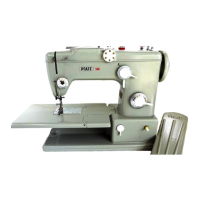The
Thread
Tens
ion
Both
threads
must
be
under
proper
tension
to
ensure a correct setting
of
stitches. Depending on the type
of
fabric being sewn
and
the
thread
size
used, both tensions must
be
balanced
so
that
the lock
of
the needle ond
bob-
bin
threads
occurs
exact
ly in the
center
of
the
mater
ial. The correct
amount
of
tension
on
the needle
thread
is
set by the upper tensi
on
(tensi
on
discs)
on
the
fr
ont
of the machi
ne
(Fig.
29),
and
on
the bobbin
thread,
by the lower tension (flat spring)
on
the bobbin
case
(Fig.
28)
.
The upper tension
is
so
designed
that all
grades
of
tension, from loose
to
tight,
con
be
covered with
one
complete turn
of
the tensi
on
dial. Any desired
degree
of
tension con
be
set by the numbers indicated on the dial. This setting
can
be
quickly restored
if
the tension should hove
been
altered for some
special sewing job.
The needle thread tensi
on
has
a third tension disc for two-needle work
so
that both threads
are
separated
in
the tension mechanism.
The
Bobbin
Thread
Tension
To
balance
the tensions correctly, begin
by
setting the
bobbin
thread tensi
on
at
a medium
grade.
To
this
end,
tighten the regulating screw until a notice-
able
resistance has
to
be
overcome when pulling the
thread
.
Determine the correct
bobbin
thread
tension by holding the
thread
end
between your fingers
and
letting the bobbin case
hang
freely. The tension
should
be
strong enough
to
keep
the bobbin case from
being
pulled down by
its
own
weight.
However
,
as
you
jerk
your
hand
slight
ly,
the
bobbin
case
should gradually slide down
(Fig.
30)
.
Regulating the
Thread
Tension
No
screwdriver
is
required
to
adjust
the bobbin thread tension on Pfaff 260
and
360 machines. Instead, the knurled screw
on
the bobbin case con
be
turned with the thumb tip,
as
follows:
Turn it left for a
looser
tension,
and
right, for a tighter tension.
Do not turn the knurled screw
too
for
out
so
that
it
wi
ll
not fall
out
and
get
lost.
15

